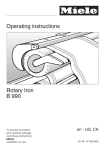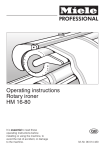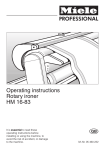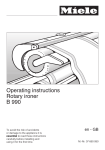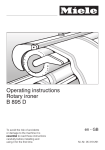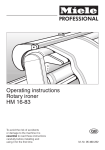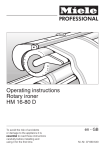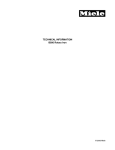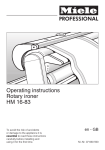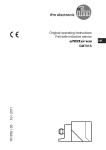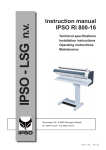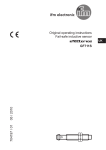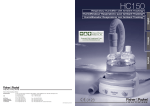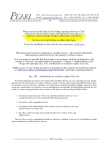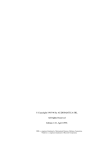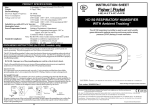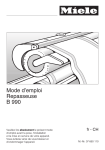Download Miele B 890 User's Manual
Transcript
Operating instructions
Rotary iron
B 890
To prevent accidents
and machine damage,
read these instructions
before
Installation or use.
UV
M.-Nr. 05 319 322
2
Contents
IMPORTANT SAFETY INSTRUCTIONS . . . . . . . . . . . . . . . . . . . . . . . . . . . . . . . . . 4
Description of the appliance . . . . . . . . . . . . . . . . . . . . . . . . . . . . . . . . . . . . . . . . . 6
Moving the appliance. . . . . . . . . . . . . . . . . . . . . . . . . . . . . . . . . . . . . . . . . . . . . . . 8
Transport strut . . . . . . . . . . . . . . . . . . . . . . . . . . . . . . . . . . . . . . . . . . . . . . . . . . . . . 8
Before using for the first time . . . . . . . . . . . . . . . . . . . . . . . . . . . . . . . . . . . . . . . 10
Power cord. . . . . . . . . . . . . . . . . . . . . . . . . . . . . . . . . . . . . . . . . . . . . . . . . . . . . . . 10
Dust cover . . . . . . . . . . . . . . . . . . . . . . . . . . . . . . . . . . . . . . . . . . . . . . . . . . . . . . . 10
Before ironing. . . . . . . . . . . . . . . . . . . . . . . . . . . . . . . . . . . . . . . . . . . . . . . . . . . . 11
Preparing the work area. . . . . . . . . . . . . . . . . . . . . . . . . . . . . . . . . . . . . . . . . . . . . 11
Preparing the laundry . . . . . . . . . . . . . . . . . . . . . . . . . . . . . . . . . . . . . . . . . . . . . . 12
Testing the finger guard . . . . . . . . . . . . . . . . . . . . . . . . . . . . . . . . . . . . . . . . . . . . . 13
Ironing . . . . . . . . . . . . . . . . . . . . . . . . . . . . . . . . . . . . . . . . . . . . . . . . . . . . . . . . . . 14
Turning on and off . . . . . . . . . . . . . . . . . . . . . . . . . . . . . . . . . . . . . . . . . . . . . . . . . 14
Selecting the ironing temperature . . . . . . . . . . . . . . . . . . . . . . . . . . . . . . . . . . . . . 14
Selecting the roller speed . . . . . . . . . . . . . . . . . . . . . . . . . . . . . . . . . . . . . . . . . . . 15
Ironing . . . . . . . . . . . . . . . . . . . . . . . . . . . . . . . . . . . . . . . . . . . . . . . . . . . . . . . . . . 16
Positioning the laundry . . . . . . . . . . . . . . . . . . . . . . . . . . . . . . . . . . . . . . . . . . . . . 17
Removing the feed board . . . . . . . . . . . . . . . . . . . . . . . . . . . . . . . . . . . . . . . . . . . 17
After ironing . . . . . . . . . . . . . . . . . . . . . . . . . . . . . . . . . . . . . . . . . . . . . . . . . . . . . . 18
Power failure . . . . . . . . . . . . . . . . . . . . . . . . . . . . . . . . . . . . . . . . . . . . . . . . . . . . . 19
Tips on ironing . . . . . . . . . . . . . . . . . . . . . . . . . . . . . . . . . . . . . . . . . . . . . . . . . . . 20
Tablecloths . . . . . . . . . . . . . . . . . . . . . . . . . . . . . . . . . . . . . . . . . . . . . . . . . . . . . . . 20
Napkins, hand towels . . . . . . . . . . . . . . . . . . . . . . . . . . . . . . . . . . . . . . . . . . . . . . 20
Sheets and bedspreads . . . . . . . . . . . . . . . . . . . . . . . . . . . . . . . . . . . . . . . . . . . . 20
Pillow cases . . . . . . . . . . . . . . . . . . . . . . . . . . . . . . . . . . . . . . . . . . . . . . . . . . . . . . 20
Duvet covers . . . . . . . . . . . . . . . . . . . . . . . . . . . . . . . . . . . . . . . . . . . . . . . . . . . . . 21
Shirts . . . . . . . . . . . . . . . . . . . . . . . . . . . . . . . . . . . . . . . . . . . . . . . . . . . . . . . . . . . 22
Pants . . . . . . . . . . . . . . . . . . . . . . . . . . . . . . . . . . . . . . . . . . . . . . . . . . . . . . . . . . . 24
Skirts . . . . . . . . . . . . . . . . . . . . . . . . . . . . . . . . . . . . . . . . . . . . . . . . . . . . . . . . . . . 24
Cleaning and Care . . . . . . . . . . . . . . . . . . . . . . . . . . . . . . . . . . . . . . . . . . . . . . . . 25
Frequently asked questions . . . . . . . . . . . . . . . . . . . . . . . . . . . . . . . . . . . . . . . . 28
After sales service . . . . . . . . . . . . . . . . . . . . . . . . . . . . . . . . . . . . . . . . . . . . . . . . 29
Electrical connection . . . . . . . . . . . . . . . . . . . . . . . . . . . . . . . . . . . . . . . . . . . . . . 30
Technical data . . . . . . . . . . . . . . . . . . . . . . . . . . . . . . . . . . . . . . . . . . . . . . . . . . . 31
Help protect our environment . . . . . . . . . . . . . . . . . . . . . . . . . . . . . . . . . . . . . . . 32
3
IMPORTANT SAFETY INSTRUCTIONS
Read the operating instructions
carefully before using this appliance
for the first time. They contain
important information about the
safety, use and maintenance of the
appliance. Please read this booklet
carefully to prevent accidents and
machine damage.
Keep these instructions in a safe
place for reference, and pass them
on to any future user.
Appropriate use
This rotary iron is intended for
ironing textiles which have been
washed in water and are suitable for
machine ironing.
Technical and electrical safety
Before setting up the rotary iron,
check for any visible damage.
Do not install or use a damaged
appliance.
A damaged appliance is
dangerous. Turn off the rotary iron,
unplug from the wall outlet and call
Technical Service.
Before connecting the appliance,
ensure that the connection data on
the data plate (fusing, voltage and
frequency) match the household
electrical supply. If in doubt, consult an
electrician.
4
The electrical safety of this
appliance can only be guaranteed
when continuity exists between the
appliance and an effective grounding
system which complies with local and
national safety regulations.
It is important that this basic safety
requirement be tested by a qualified
electrician.
The manufacturer will not be held
responsible for damages caused by the
lack, or inadequacy, of an effective
grounding system.
This appliance is built in
accordance with current safety
requirements. Unauthorized repairs
could be hazardous for the user, for
which the manufacturer cannot accept
responsibility. Repairs should only be
performed by a Miele authorized
technician.
Ensure that power is not restored to the
appliance while maintenance or repair
work is being performed.
Faulty components must only be
replaced with original Miele spare
parts. Only original spare parts
guarantee the safety of the appliance.
The appliance is completely
isolated from the electricity supply
when:
– it is turned off at the wall switch and
unplugged, or
– the circuit breaker has been
"tripped".
IMPORTANT SAFETY INSTRUCTIONS
Do not damage, remove or bypass
the safety components or control
elements of the appliance.
Only operate the rotary iron when
all removable outer casings are
fitted so that it is impossible to touch an
electrical component or moving part.
This equipment has not been
designed for maritime use or for
use in mobile installations such as
aircraft or recreational vehicles.
However, under certain circumstances
it may be possible for an installation in
these applications. Please contact the
nearest Miele Dealer or Miele Technical
Service with specific requirements.
Use
Never allow children to play on or
near the rotary iron or to operate it
themselves.
When the rotary iron is heated
there is a danger of burns:
The swing out bar is only to be
used to hang laundry. Swing it
back immediately after use. Take care
not to press down on the bar when it is
swung out. This could tip over the
rotary iron.
Turn the appliance off before
removing the plug from the
electrical outlet.
Pull only on the plug and not on the
power cord.
Do not lay the power cord over the
heater plate when it is heated. This
could damage the cord - danger of
electric shock.
Use the cable holders attached to the
appliance to secure the cord.
Accessories
Accessories should only be used if
approved by Miele. If other parts
are used, warranty, performance and
product liability claims may be void.
– if the heater plate is touched.
– if the foot pedal is pressed down
while fingers or hands are positioned
between the raised heater plate and
the roller to smooth an item.
Never drape items over the heater
plate when it is heated.
This is a fire hazard. Hang laundry on
the swing out bar.
5
Description of the appliance
1 Finger guard
7 Ironing table
2 Temperature selector
8 Bar for hanging ironed laundry
3 Emergency release
9 Feed board
4 Release catch
(underneath ironing table)
10 Roller with ironing cover
5 Power cord
6 Foot pedal switch
6
11 Heater plate
Description of the appliance
Control panel
1 "I - 0" ("on/off") button
for turning the rotary iron on and off
2 Roller speed selector
3 Temperature indicator "°C"
7
Moving the appliance
Transport strut
Moving the appliance
The rotary iron has four rollers.
^ Pull the transport strut out (see
illustration).
Keep the transport strut in a safe place.
It must be re-fitted if the appliance has
to be moved again (e.g. when moving
to a new home).
If the transport strut is in place, only
transport the rotary iron in a folded
position.
8
^ Hold the rotary iron with the ironing
table and push or pull to move it.
To steer and to overcome obstacles
like carpet edges and doorways:
^ Slightly tilt the appliance.
The rotary iron can be moved either
when assembled or folded.
Moving the appliance
^ Hold the ironing table and release the
catch, located on the right hand side
at the back, underneath the ironing
table.
^ Swing the top section of the rotary
iron to the side until it clicks
horizontally into position.
9
Before using for the first time
Power cord
Dust cover
The power cord is wound around a
hook underneath the ironing table.
The dust cover which protects the roller
during transportation must be removed.
^ Unwind the cord.
^ First remove the feed board by lifting
it out of the right hand holder, then
pull it out to the left of the roller.
,Do not insert the plug into the
electrical socket yet.
* The plug shown is for illustration only.
^ Plug the appliance in and turn it on.
The heater plate will rise
automatically.
^ The protective dust cover can now
be pulled off.
10
Before ironing
Preparing the work area
Place close by:
– a basket with the laundry ready for
ironing to the left of the rotary iron,
– a surface for the ironed laundry to
the right of the rotary iron.
Shirts, overalls, blouses, etc., should be
hung on hangers immediately after
ironing.
Small items can be hung over the swing
out bar.
Have some water ready for redamping
the laundry if necessary.
A height adjustable chair and a flat
surface, like a table to lay ironed
laundry on, are useful.
When positioning the rotary iron
horizontally be sure to secure the
appliance so that it does not roll.
11
Before ironing
Preparing the laundry
Correct preparation of the laundry is
essential for easy ironing.
Before ironing, the laundry should be:
Pulling into shape and smoothing
out
^ Pull the dampened laundry into
shape as usual.
^ Smooth out ribbons, straps, seams
and hems.
– dampened
– pulled into shape and smoothed out
– sorted.
Correct dampness
The laundry needs to be sufficiently
damp, so that on the first pass through
the rotary iron at the correct
temperature, it will come out smooth
and dry. Dampen the laundry as you
would for hand ironing, preferably
several hours beforehand so that the
articles achieve a uniform degree of
dampness throughout.
^ Large items such as table cloths, bed
linens, etc. should be folded
lengthways into a number of pleats
so that they can be ironed as easily
as possible.
Sorting
^ Sort the laundry according to how
much heat is required for ironing.
Start ironing at a lower temperature and
gradually increase the temperature
according to the fabric being ironed.
If a tumble dryer is being used, select a
"Machine iron" program.
Perlon, Nylon, etc. ß
^ If preparation time is short use warm
water to redampen.
Woolens, Silk
ßß
Cottons, Linen
ßßß
Material
Silk
Dampness for ironing
wrap in a damp cloth
to avoid water marks
Synthetics
slightly damp to dry
e.g. Nylon,
Polyester, etc.
Wool
e.g. pants
press under a damp
cloth
Cotton
slightly damp
Linen
quite damp
12
^ Iron starched items last to avoid any
starch deposits on other items.
Before ironing
Testing the finger guard
The finger guard is a safety feature
and should be checked each time
the rotary iron is used.
^ With the rotary iron turned on, press
the foot pedal down.
The heater plate comes down onto the
rotating roller.
Please note:
Any unevenness in the ironing cover
will smooth itself out after 3 hours of
use.
When using a new machine, if delicate
laundry is not properly pulled into the
rotary iron continue ironing. This is
usually solved after 5-10 minutes of
ironing.
If a new ironing cover is used, wash the
cloth at a high temperature (140°F/
60°C) to achive an optimal pull-in of the
laundry.
^ If you lift the finger guard now, the
roller stops rotating and the heater
plate rises.
This shows that the finger guard is
working.
^ Let go of the finger guard and
remove your foot from the foot pedal.
^ Press the foot pedal down again.
The heater plate lowers and the roller
rotates.
13
Ironing
Turning on and off
Selecting the ironing
temperature
The temperature selector is used to set
the ironing temperature.
The temperature range is marked by
dots on the ring around the temperature
selector. These correspond with the
international fabric care symbols for
ironing.
The rotary iron is turned on and off with
the "I / 0" button.
To turn on
^ Press the button in.
The indicator light comes on.
To turn off
^ Press and release the button.
The indicator light goes out.
14
Material
Dot
symbol
Temperature
range
Polyester /
artificial silk
ß
cool iron
(low temperature)
Silk /
Wool
ßß
medium hot iron
(medium
temperature)
Cotton /
Linen
ßßß
hot iron
(high temperature)
Ironing
Selecting the roller speed
There are 5 roller speed settings, from
low (approximately 6.5 ft/min.[2 m/min])
to high 15 ft/min. [4.5 m/min]).
A lower roller speed makes it easier to
iron complicated articles such as shirts
and blouses. It is also best to select a
low roller speed when ironing folded
items, which may require more than one
pass through the rotary iron to get them
smooth and dry.
^ Turn the temperature selector to the
desired temperature.
Thinner, single thickness items,
e.g. handkerchiefs can be ironed at a
higher roller speed.
The temperature "C°" indicator will light
while the heater plate is heating up.
The light will go out when the
temperature selected is reached.
When ironing a fabric blend,
e.g. poly cottons, the more delicate
fiber determines the ironing
temperature. However, if there is
more cotton than polyester, the item
can be ironed on the ßß Silk / Wool
setting.
Do not use the the cotton setting.
^ Set the roller speed selector to the
desired speed.
15
Ironing
Ironing
To iron
The ironing process is controlled by the
foot pedal which has three operating
positions:
^ Press the foot pedal down to the floor.
,Do not put fingers between the
heater plate and the roller.
Danger of burning and injuring
fingers.
To press
^ First press the foot pedal down to the
floor and then lift your foot up a little
so that the heater plate remains in
position but the roller does not rotate.
To raise the heater plate
^ Take your foot off the pedal.
– raising the heater plate (rest)
– pressing
– ironing
16
Ironing
Positioning the laundry
Removing the feed board
^ Arrange the laundry items on the
feed board so that they are straight
and then smooth out.
The feed board can be removed when
shaped garments are being ironed,
e.g. skirts (round).
^ Then turn the roller by hand, always
keeping your hands away from the
heater plate, so that the edge of the
item to be ironed can be held by the
heater plate.
^ Lift the feed board out of the right
hand holder and then pull it out to the
left of the roller.
^ Press down the foot pedal.
Ironed laundry can be hung over the
swing out bar to avoid creasing.
Laundry bar
,Take care not to press down on
the bar when it is swung out, this
could cause the rotary iron to tip
over.
17
Ironing
Ironing tips
After ironing
– To avoid creasing stop the roller, pull
the item back slightly and smooth
out. If necessary, dampen again with
a wet cloth or spray bottle.
^ Turn the appliance off.
– If possible, always use the whole
length of the roller, otherwise the
roller will lose its elasticity.
– For small items such as
handkerchiefs, alternate between
using the right and left hand sides of
the roller.
– Items with raised buttons should be
ironed face down on to the roller so
that they are pressed into the
cushioned surface.
– Cover zippers, metal buttons, and
metal hooks with a cloth to protect
the heater plate.
– To protect the heaterplate do not iron
buttons that are not heat resistant or
very large.
– When you have nearly finished
ironing you can turn the temperature
selector to " g " cold and continue
ironing small items with residual heat.
18
^ Turn the temperature to " g " cold.
^ Remove the plug from the outlet.
If the rotary iron is to be stored away
^ Allow the heater plate to cool.
^ When the heater plate has cooled
completely, fold the rotary iron.
^ Wind up the power cord.
^ Pull the cover on.
Ironing
Power failure
To free the trapped item
In the event of a power failure, pull
the emergency release lever up.
If there is a power failure when the
rotary iron is in use, the heater plate will
stay on the roller. The item being ironed
will be held there possibly becoming
scorched.
^ Pull the emergency release lever up.
The pressure is reduced and the item
can be removed.
^ When power has been restored (the
indicator in the On/Off switch comes
on) push the emergency release
lever back down. Continue ironing as
usual.
19
Tips on ironing
Tablecloths
Napkins, hand towels
^ Avoid folds by ironing the middle first.
^ Lay the item with the straight grain of
the fabric to the feed board.
This will prevent it from loosing its
shape and will be easier to fold.
Pass handkerchiefs diagonally through
the rotary iron and, if necessary, fold
them and then iron again.
^ Please use the whole length of the
roller.
Sheets and bedspreads
^ Place the tablecloth crossways so
that the ends hang over to the left
and right.
^ Iron the middle section.
Sheets may be ironed like tablecloths,
or if a lengthwise fold is acceptable,
fold the sheet together lengthwise and
iron it on both sides.
To accentuate embroidery and raised
patterns on bedspreads, iron first in
one direction and then in the other.
Pillow cases
^ Lay the pillowcase on the feeder
plate, position under the heater plate
and iron in one step.
If the open end has buttons, only
pass it through the rotary iron if the
buttons are heat resistant.
^ Fold in half with unironed edges
together and place over the left end
of the roller with the ironed middle
section hanging over the edge to
prevent creasing. Then pass both
sides of the the non ironed sections
through the rotary iron.
20
Tips on ironing
Duvet covers
To iron without a fold
If the duvet cover has buttons at the
open end, iron the buttons first.
^ It is best to iron the cover in two runs
lengthwise.
Note: Only pass this end through the
rotary iron if the buttons are
heat-resistant.
If folds are acceptable
^ Start the first run by carefully feeding
this end in first on the left side of the
roller, taking care not to damage any
buttons.
^ Fold the duvet cover lengthwise and
iron both sides.
21
Tips on ironing
Shirts
3. Front sides
^ Remove the feed board to iron shirts.
1. Shoulder yoke
^ Lay the button hole front on the left
hand end of the roller with the side
seam along the edge of the roller.
^ Arrange the yoke, collar first, on the
roller and smooth out.
^ Iron from the button hem up to the
armhole.
^ Hot press the yoke.
^ Now move the shirt out and iron past
the armhole to the side seam.
2. Collar
^ Iron the button side inside out so the
buttons are pressed into the
cushioned surface of the roller.
The collar is ironed on both sides using
the left hand end of the roller.
^ Then turn down the collar and press
lightly, holding taut.
22
Tips on ironing
4. Back
5. Cuffs and sleeves
^ Start at the side seam. Pull the shirt
over the roller as far as the arm hole.
Smooth it out.
^ First iron both sides of the cuff on the
left edge of the roller. Fold
double-cuffs with one button hole
placed over the other one and press
lightly.
^ Starting from the side seam iron past
the armhole, then pull the shirt further
onto the roller and iron the full back
length to the second arm hole.
^ Pull the shirt further down the roller
and iron past the arm hole.
^ Smooth out the sleeve and place it on
the edge of the roller.
^ Iron the arm from the edge of the cuff
to the underarm. Shift diagonally to
iron the full width of the arm hole.
23
Tips on ironing
Pants
Skirts
Ironing pants and jeans
These are best ironed without the feed
board.
^ Iron the upper part from waistband to
inseam of pants and jeans in
sections. Set on a slow speed.
^ Pull the skirt over the roller from the
hem to the waistband.
^ Iron the legs from hem to inseam one
leg after another.
Pressing woolen and dress pants
^ Lay the pant legs separately on the
roller. Let the upper part hang down
over the left hand edge of the roller.
^ Cover with a damp cloth. Then turn
the roller by hand until the part of the
pants to be pressed is covered by
the heater plate.
^ Press each leg from both sides
starting from the crease.
24
^ Lay a damp cloth over it.
^ Iron each section of the skirt in turn.
Cleaning and Care
Cleaning the heater plate
^ Remove the feed board.
^ Check that the temperature selector
is set " g " (cold).
^ Allow the heater plate to cool before
cleaning.
^ Clean lime or starch deposits from
the heater plate using a non abrasive
household cleaner. Avoid spraying
the heater plate.
Do not use abrasive cleaners.
Cleaning the casing
^ Depending on soiling, the casing can
be wiped down with a dry or damp
cloth.
^ Untie the old ironing cover cords at
each end of the roller.
Do not use abrasive cleaners.
Washing or replacing the
ironing cover
It is normal for the ironing cover on the
roller to become slightly brown with
use.
^ Wash the cover with a hot
temperature program (140°F [60°C]).
If the cover looks worn and used, it can
be easily replaced.
Ironing covers are available at your
Miele dealer or Miele.
^ Unwind the old ironing cover.
,The ironing cover should only be
changed when the appliance is
cold.
25
Cleaning and Care
^ Completely unwind the padding
cover attached to the roller and let it
hang down smoothly.
^ Hold the corners of the padding
cover, pull taut and keeping taut lay
over the heater plate.
The slot which holds the ironing
cover is now at the top.
26
^ Insert the long edge of the new
ironing cover into the retaining slot
with the side seams inside (upside
down). Keep side ties hanging free
and smooth out.
^ Turn the roller by hand in the
direction you iron (see arrow) until the
retaining slot is at the bottom.
^ Turn the rotary iron on.
Cleaning and Care
^ Press the foot pedal and "iron" the
new cloth around.
Do not let the cords get under the
cloth as it turns.
After the roller has gone through three
or four revolutions and the end of the
ironing cover is under the heater plate:
^ Tighten the cords at the left and right
hand sides of the roller, tie together
and tuck in.
^ Put the feed board back in place.
^ Turn the rotary iron on - the heater
plate will rise.
^ Turn the rotary iron off while keeping
the foot pedal pressed down.
The ironing cover is held firmly in place
with the heater plate which is still
lowered.
27
Frequently asked questions
,Repairs should only be carried out by an authorized technician in
accordance with local and national safety regulations. Unauthorized repairs
could cause injury or appliance damage. The manufacturer cannot be held
responsible for unauthorized work.
The rotary iron does not turn.
Possible fault
Fix
The rotary iron has no power.
Plug the machine in and check if the circuit
breaker has tripped.
The laundry is not properly or poorly pulled in.
This tends to happen when ironing Continue ironing, the issue is usually
delicate items with a new machine. resolved after 5-10 minutes of ironing.
New iron cover
A new rotary iron cover should be washed at
140°F (60°C) for the laundry to be ideally
pulled in.
Lime or starch deposits on the
heater plate.
Clean with household cleaners or
dishwasher detergent.
Creases/Folds occur
The heater plate is soiled (lime
deposits).
Clean the heater plate with household
cleaners or dishwasher detergent.
The rotary iron cover is heavily soiled.
Deposits
Wash the iron cover with houshold detergent
at 140°F (60°C) or replace with a new one.
See "Washing or replacing the ironing
cover".
The heater plate does not press on the roller.
The emergency release was
activated.
28
Press the emergency release down
(see "Power failure").
After sales service
In the event of a problem, please
contact the Miele Technical Service
Department.
When contacting the Technical Service
Department, please quote the Model
and Serial number of your appliance,
both are shown on the data plate,
located underneath the front side of the
ironing table.
a Model
b Serial number
c Voltage / frequency
d Minimum fuse rating
e Total rated load
The wiring diagram is located under the
right side of the ironing table.
MieleCare
(for Miele US only)
MieleCare, our Extended Service
Contract program; gives you the
assurance of knowing that your
appliance investment is covered by 5
years of worry free ownership.
MieleCare is the only Extended Service
Contract in the industry that guarantees
repairs by a Miele Authorized Service
Provider using genuine Miele parts.
Only genuine Miele parts installed by
factory trained professionals can
guarantee the safety, reliability and
longevity of your Miele appliance.
Please note that unless expressly
approved in writing by the Miele
Service department, Extended Service
Contracts offered by other providers for
Miele products will not be recognized
by Miele. Our goal is to prevent
unauthorized (and untrained) service
personnel from working on your Miele
products, possibly doing further
damage to them, you and/or your
home.
To learn more about MieleCare
Extended Service Contracts, please
contact your appliance dealer or visit
us online at:
www.store.miele.com
29
Electrical connection
Electrical connection 110 V
Important
The appliance is supplied with a power
cord and NEMA 5-15 P plug ready for
connection to an a.c. single phase
110 V 60 Hz supply (see data plate).
The fuse rating is 15 amps.
If it is necessary to change the plug or
power cord of the rotary iron, please
take note of the following color codes of
the wires:
Electrical connection 208 V or 240 V
The appliance is supplied with a power
cord and NEMA 6-20 P plug ready for
connection to an a.c. single phase
208 V 60 Hz supply.
The fuse rating is 20 amps.
Wall outlet: NEMA 6-20 R, for a 20 A,
120 V.
,Do not modify the machine
power cord or plug, the machine is
approved for US and CDN.
All electrical work should be carried
out by a qualified electrician in
accordance with local and national
safety regulations.
Do not connect the rotary iron to an
extension cord. Extension cords do
not guarantee the required safety of
the appliance (e.g. danger of
overheating).
30
Green/yellow = ground
Blue
= live 1
Brown
= live 2
WARNING
THIS APPLIANCE MUST BE
GROUNDED
Technical data
Height
37 3/4" (folded 41 3/8") [95.9 (folded 105.2) cm]
Width
38 3/4" (folded 19 5/8") [98.5 (folded 50) cm]
Depth
15" [38 cm]
Weight
84 Ibs [38 kg]
Voltage
see data plate
Rated load
see data plate
Minimum fuse rating
see data plate
31
Help protect our environment
Disposal of packing materials
Disposal of an old appliance
The packing materials are
biodegradable and recyclable.
Please recycle.
Old appliances contain materials that
can be recycled. Please contact your
local recycling authority about the
possibility of recycling these materials.
Turn off and unplug the appliance from
the outlet. Cut off and render any plug
useless. Cut off the power cord directly
behind the appliance to prevent
misuse.
Ensure that the appliance presents
no danger to children while waiting
for disposal.
32
33
34
35
Alteration rights reserved / 2306
M.-Nr. 05 319 322 / 04
en - US




































